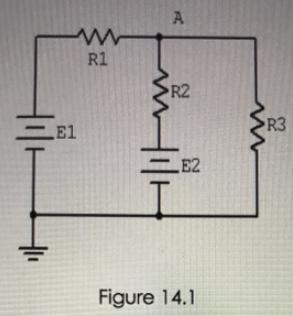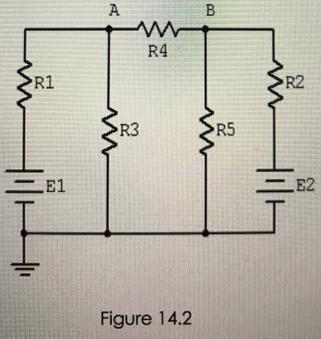1. Do the polarities of the sources in Figure 14.1 matter as to the resultingvoltages? Will the magnitudes of the voltages be the same if
1. Do the polarities of the sources in Figure 14.1 matter as to the resultingvoltages? Will the magnitudes of the voltages be the same if one or both sources have an inverted polarity?
2. In both circuits of this exercise the negative terminals of the sources are connected to ground. Is this a requirement for nodal analysis? What would happen to the node voltages if the positions of E1 and R1 in Figure 14.1 were swapped?
3. If mesh analysis was applied to the circuit of Figure 14.2, how many unknown currents would have to be analyzed and how many equations would be needed? How does this compare to nodal analysis?
4. The circuits of Figures 14.1 and 14.2 had been analyzed previously in the Superposition Theorem and Mesh Analysis exercises. How do the results of this exercise compare to the earlier results? Should the resulting currents and voltages be identical? If not, what sort of things might affect the outcome?
5. In general, compare and contrast the application of Superposition, Mesh and Nodal Analyses to multi- source DC circuits. What are the advantages and disadvantages of each? Are some circuits better approached with a particular technique? Will each technique enable any particular current or voltage to be found or are there limitations?


A R1 R2 R3 LEl E2 Figure 14.1 A R4 R1 R2 R3 R5 LE1 E2 Figure 14.2
Step by Step Solution
3.41 Rating (151 Votes )
There are 3 Steps involved in it
Step: 1
1 Since as we know ground is reference or at zero potential the source E1 if only inverted will result in positive polarity of E1 facing ground or zer...
See step-by-step solutions with expert insights and AI powered tools for academic success
Step: 2

Step: 3

Ace Your Homework with AI
Get the answers you need in no time with our AI-driven, step-by-step assistance
Get Started


